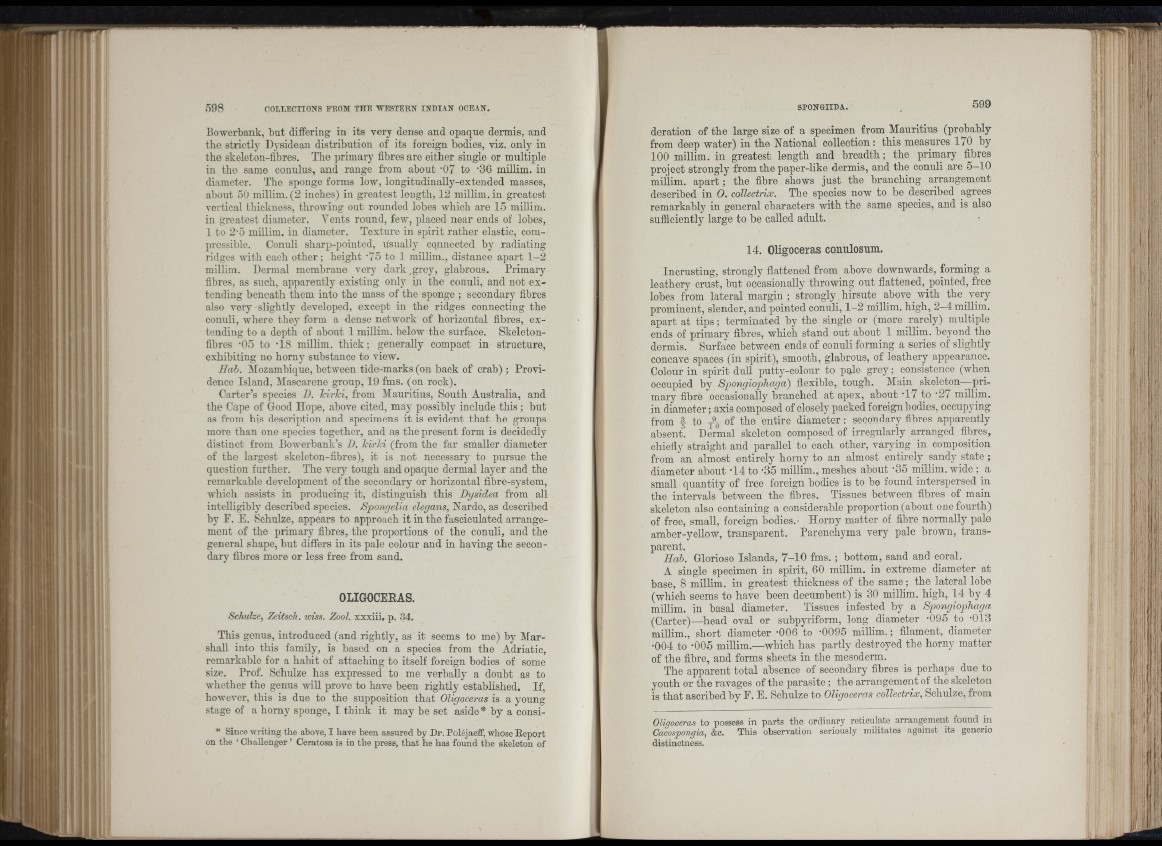
n i l,
Bowerbank, but differing in its very dense and opaque dermis, and
tbe strictly Dysideau distribution of its foreign bodies, viz. only in
tbe skeleton-fibres. Tbe primary fibres are either single or multiple
in tbe same couiüus, and rauge from about '07 to '36 millim. in
diameter. The sponge forms low, longitudinally-extended masses,
about 50 millim. (2 inches) in greatest leugtb, 12 millim. iu greatest
vertical thickness, throwing out rounded lobes which are 15 millim.
in greatest diameter. Agents round, few, placed near ends of lobes,
1 to 2-5 millim. in diameter. Texture in spirit ratber elastic, compressible.
Conuli sharp-pointed, usually connected by radiating
ridges witb each other; height ’75 to 1 millim., distance apart 1-2
millim. Dermal membrane very dark grey, glabrous. Primary
fibres, as such, apparently existing only in the conuli, and not extending
beneath them into tbe mass of the sponge ; secondary fibres
also very slightly developed, except in the ridges connecting the
conuli, where they form a dense network of horizontal fibres, extending
to a depth of about 1 millim. below tbe surface. Skeleton-
fibres -05 to -18 millim. thick; generally compact in structure,
exhibiting no horny substance to view.
Hab. Mozambique, between tide-marks (on back of crab) ; Providence
Island, Mascarene group, 19 fms. (on rock).
Carter’s species D. Tcirhi, from Alauritius, South Australia, and
the Cape of Good Hope, above cited, may possibly include tbis ; but
as from his description and specimens it is evident th at be groups
more than one species together, and as tbe present form is decidedly
distinct from Bowerbank’s D. k ir li (from tbe far smaller diameter
of tbe largest skeleton-fibres), it is . not necessary to pursue tbe
question further. The very tough and opaque dermal layer and tbe
remarkable development of tbe secondary or horizontal flbre-system,
which assists in producing it, distinguish this Dysidea from all
intelligibly described species. Spongelia elegans, Nardo, as described
by F. E. Schulze, appears to approach it in the fasciculated arrangement
of tbe primary fibres, the proportions of the conuli, and the
general shape, but differs in its pale colour and in having tbe secon -
dary fibres more or less free from sand.
OLIGOCERAS.
Schidze, Zeitsch. wiss. Zool. xxxiii, p. 34.
This genus, introduced (and rightly, as it seems to me) by Alar-
shaU- into tbis family, is based on a species from the Adriatic,
remarkable for a habit of attaching to itself foreign bodies of some
size. Prof. Schulze bas expressed to me verbaUy a doubt as to
whether the genus wiU prove to bave been rightly established. If,
however, this is due to tbe supposition th a t Oligoceras is a young
stage of a horny sponge, I think it may be set aside* by a consi*
Since writing the above, I have been assured by Di’. Poléjaeff, wbose Eeport
on the ‘ Challenger ’ Ceratosa is in the press, that he has found the skeleton of
deration of tbe large size of a specimen from Manritius (probably
from deep water) in tbe National collection : tbis measures 170 by
100 millim. in greatest length and b read th ; tbe primary fibres
project strongly from the paper-like dermis, and tbe conuli arc 5-10
millim. a p a rt; tbe fibre shows just tbe branching arrangement
described in 0. collectrix. The species now to be described agrees
remarkably in general characters witb the same species, and is also
sufiiciently large to be called adult.
14. Oligoceras conulosum.
Incrusting, strongly flattened from above downwards, forming a
leathery crust, but occasionally throwing out flattened, pointed, free
lobes from lateral margin; strongly,hirsute above with the very
prominent, slender, and pointed connli, 1 -2 millim. high, 2 -4 millim.
apart at tip s ; terminated by tbe single or (more rarely) multiple
ends of primary fibres, wbicb stand out about 1 millim. beyond tbo
dermis. Surface between ends of conuli forming a series of slightly
concave spaces (in spirit), smooth, glabrous, of leathery appearance.
Colour in spirit duU putty-colour to pale g rey ; consistence (when
occupied by Spongiophaga) flexible, tough. Main skeleton primary
fibre occasionally branched at apex, about ’17 to ‘27 millim.
in diameter; axis composed of closely packed foreign bodies, occupying
from f to Gh- of tbe entire diameter : secondary fibres apparently
absent. Dermal skeleton composed of irregularly arranged fibres,
chiefly straight and parallel to each other, varying in composition
from an almost entirely horny to an almost entirely sandy state ;
diameter about -14 to -35 miUim., meshes about -35 millim. wide ; a
small quantity of free foreign bodies is to be found interspersed in
the intervals between the fibres. Tissues between fibres of main
skeleton also containing a considerable proportion (about one fourtb)
of free, small, foreign bodies.- Horny matter of fibre normally pale
amber-yellow, transparent. Parenchyma very pale brown, transparent.
Hab. Glorioso Islands, 7 -10 fm s .; bottom, sand and coral.
A single specimen in spirit, 60 millim. in extreme diameter at
base, 8 millim. in greatest thickness of the same; the lateral lobo
(wbicb seems to have been decumbent) is 30 millim. high, 14 by 4
millim. in basal diameter. Tissues infested by a Spongiophaga
(Carter)—bead oval or subpyriform, long diameter -095 to -013
millim., short diameter -006 to -0095 millim.; filament, diameter
•004 to -005 millim.—wbicb bas partly destroyed the horny matter
of the fibre, and forms sheets in the mesoderm.
Tbe apparent total absence of secondary fibres is perhaps due to
youth or tbe ravages of the parasite ; the arrangement of the skeleton
is th a t ascribed by F. E. Schulze to Oligoceras collectrix, Schulze, from
Oligoceras to possess in parts the ordinary reticulate arrangement found in
Cacospongia, &c. This observation seriously militates against its generic
distinctness.